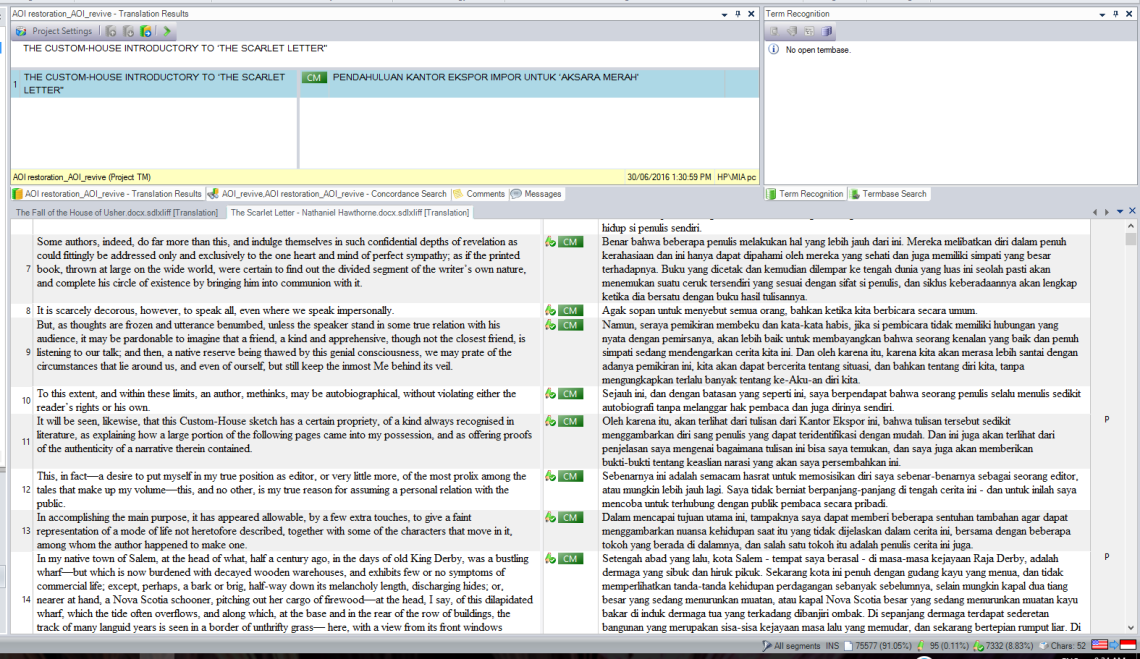(Berikut adalah isi dari makalah yang saya ajukan untuk Transcon 2016 di Atmajaya lalu. Isinya saya bagi menjadi dua bagian agar tidak bikin eneg ketika dibaca, ha ha. Semoga bermanfaat).
Translating 18th-19th century’s literature work has been one of the most difficult works throughout my experience as a translator. The nature of this type of translation is difficult because translators are “forced” to do a “rewrite” job, and there is the need to communicate the contents smoothly and to merge the boundaries between cultures, to make the content acceptable and readable for a much broader audience compared to regular documents, and at the same time maintaining the idea and gist of the original writer.
I have been using Trados throughout my life as a translator, and eventually I was intrigued to utilize this CAT tool to approach 18th-19th centuries literary translation work. I was requested by one of my clients to translate The Age of Innocence – a literature from the 19th century – from English to Indonesian. I then decided that I should utilize Trados to approach this type of translation. I succeeded and then used the same approach to translate the short stories The Turn of The Screw, and eventually The Fall of The House of Usher, all which gave favourable results (minimum editing time, more focused, comprehensible and traceable results, even when dealing with the poetry section that was a signature of Edgar Allan Poe’s work).
Now I am using the same approach to translate 18th century’s The Scarlet Letter (still in progress). I believe that Trados has helped me a lot in making the translation process easier. I will share some of my process in translating, including the number of commands in Trados version 2014 that will enable literary translators (and hopefully, one day also literary editors) to fully concentrate on the tasks at hand and complete them effectively.
ABOUT CAT TOOLS
CAT tool (Computer Aided Translation tool) has become an important tool in a translator’s life. Basically what this software does is managing translation work, and the role of CAT tool became increasingly important when clients from different countries need translations from several different resources. This software helps them to manage translation results and also to keep data (in a relatively small size) to reuse them later when needed.
For freelance translators, CAT tools serves as database management software as well as an aid in translation processes. This software keeps the database up to date as the freelance translator continues to receive projects/work, and they will be able to update, change, revise, and also edit their translation work in this software, while keeping the format intact and relatively unchanged (i.e only requires a small amount of adjustments).
Trados is one of the most used CAT tools. This software was first introduced in 1994 under the name of “Translator’s Workbench” by Trados GmBH, Germany (Wikipedia, https://en.wikipedia.org/wiki/SDL_Trados), then acquired by SDL in 2005 and they have released a number of versions to date. This software offers a lot of management strategies as well as a number of aids to help translators to improve their work’s quality. Its functions includes managing projects, files, translation memories, terminologies, correcting typos based on preloaded dictionaries, and also Quality Assurance that helps to correct the translation result format to be the same as the source.
Every CAT tool has several similarities, but the most prominent one – and the one that has become the source of difficulties for many translation works – is the segmented view. Segmentation in Trados is generally like this:

(Image: my current work for The Scarlet Letter. Not yet edited)
For translators this segmented view can hamper their ability to define the document’s context. They were “forced” to concentrate on each sentence (or each segment) and the generally strict Quality Assurance (not fine-tuned) provided no room for context-based translation, while Indonesian language often needs context-based translation rather than word to word (literal) translation. During my course as a professional freelance translator, I often encountered literary work translators who avoided using Trados because of its segmented view and the difficult features of the software, when actually Trados 2014 can offer an effective translation process if its other functions are explored.
ABOUT 18TH-19TH CENTURIES LITERARY WORK
During my experience as a freelance translator, translating 18th-19th centuries literary work is one of the most difficult translation works to do. The text contains various words that were not known/not used anymore in daily life, thus giving me a hard time in searching for the word meaning. I often have to revisit the online dictionary several times to just comprehend one word, and the process became truly ineffective when dealing with a large number of texts in MS Word application.
To my knowledge, translating literary work has always been about transforming the idea and the gist of the writer to another language, rather than word per word translation. This effort became difficult for 18th-19th centuries literary work because the content is often lengthy, one sentence can consist of several clauses and so there were times when I was “lost in translation” among the jungle of word meanings. And so the content was incomprehensible if not baffling, and eventually I got lost in the context every time.
Because of the difficult nature of the text, then I decided to take this 18th-19th centuries literary translation works to another level, which is to manage and to process the work using Trados 2014.
(Untuk bagian 2, klik di sini)


1 Comment